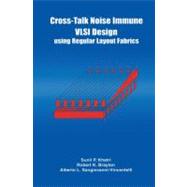
| List of Figures | p. ix |
| List of Tables | p. xii |
| Preface | p. xiii |
| Acknowledgments | p. xv |
| Introduction | p. xvii |
| Introduction | p. 1 |
| Cross-talk in DSM IC Design | p. 1 |
| Book Overview | p. 2 |
| Book Outline | p. 4 |
| Validating Deep Sub-Micron Effects | p. 7 |
| Chapter Overview | p. 7 |
| Trends in DSM VLSI Interconnect | p. 7 |
| Predicting VLSI Process Technology Trends | p. 9 |
| Extracting On-chip Layout Parasitics | p. 10 |
| Capacitance | p. 10 |
| Validating Cross-talk Effects | p. 14 |
| Delay Variation | p. 14 |
| Signal Integrity | p. 16 |
| Review of Existing Techniques | p. 17 |
| Overview | p. 17 |
| Layout-based Techniques | p. 17 |
| Ad-hoc Approaches | p. 17 |
| Custom Layout | p. 18 |
| The DEC Alpha Solution | p. 18 |
| Design CAD based Techniques | p. 19 |
| Post-layout Methods | p. 19 |
| Constraint-driven Methods | p. 19 |
| PLA based Techniques | p. 20 |
| Our Approach | p. 20 |
| Chapter Summary | p. 20 |
| Vlsi Layout Fabrics | p. 23 |
| Chapter Overview | p. 23 |
| Our Dense Wiring Fabric (DWF) | p. 23 |
| Parasitics in the DWF | p. 25 |
| Capacitance | p. 25 |
| Inductance | p. 27 |
| Advantages | p. 28 |
| Delay variation | p. 28 |
| Signal Integrity | p. 31 |
| Power Supply Resistance | p. 33 |
| Uniform and Predictable Inductance | p. 33 |
| Tighter control of t[subscript ins] | p. 34 |
| One-time Parasitic Extraction | p. 34 |
| Applicability of CAD Techniques | p. 34 |
| Routing Flexibility | p. 35 |
| Applicability to Special Circuits | p. 35 |
| Global Clocking | p. 35 |
| Disadvantages | p. 35 |
| Chip Area | p. 36 |
| Total Capacitance | p. 36 |
| Chapter Summary | p. 36 |
| Fabric1 - Fabric Cell Based Design | p. 39 |
| Chapter Overview | p. 39 |
| Design Flow 1 | p. 39 |
| Design Methodology | p. 40 |
| Experimental Results | p. 42 |
| Design Flow 2 | p. 47 |
| Design Methodology | p. 47 |
| Experimental Results | p. 48 |
| Chapter Summary | p. 51 |
| Fabric3 - Network of Pla Based Design | p. 53 |
| Chapter Overview | p. 53 |
| Programmable Logic Arrays | p. 54 |
| Introduction | p. 55 |
| PLAs in DSM VLSI Design | p. 56 |
| Electrical Characterization | p. 57 |
| Discussion | p. 60 |
| Networks of Programmable Logic Arrays | p. 61 |
| Synthesis Algorithms for the Network of PLAs Methodology | p. 61 |
| Overview | p. 61 |
| Folding Algorithm | p. 62 |
| Results | p. 63 |
| Clustering Algorithm | p. 63 |
| Results | p. 65 |
| Other Clustering Algorithms | p. 66 |
| Design Flow 1 | p. 67 |
| Design Methodology | p. 67 |
| Experimental Results | p. 67 |
| Design Flow 2 | p. 69 |
| Design Methodology | p. 69 |
| Experimental Results | p. 70 |
| Discussion | p. 73 |
| Cross-talk Problems and our Benchmark Examples | p. 73 |
| Exploring an Alternative to the DWF | p. 74 |
| Inter-Macro Wiring in the DWF | p. 75 |
| Chapter Summary | p. 75 |
| Wire Removal in a Network of Plas | p. 79 |
| Chapter Overview | p. 79 |
| Binary SPFDs | p. 81 |
| Definitions | p. 81 |
| Wire Removal/Replacement Using Binary valued SPFDs | p. 82 |
| MV-SPFDs | p. 82 |
| Definitions | p. 83 |
| Wire Removal/Replacement Using MV-SPFDs | p. 84 |
| Controlling change | p. 86 |
| Multi-valued SPFDs vs binary SPFDs | p. 87 |
| Experimental Results | p. 87 |
| Experiment 1 | p. 88 |
| Experiment 2 | p. 89 |
| Chapter Summary | p. 93 |
| Conclusions and Future Directions | p. 95 |
| Conclusions | p. 95 |
| Future Work | p. 97 |
| Alternate Fabrics | p. 97 |
| Modifications to the Routing Methodology | p. 98 |
| Modifications to the PLA Design | p. 98 |
| Alternate Circuit Design Styles | p. 99 |
| Reducing Power Consumption | p. 100 |
| Wire Removal | p. 101 |
| Alternative Clustering Strategies | p. 101 |
| "Pre-fabricated" Fabric based Circuits | p. 101 |
| Appendices | p. 107 |
| Standard Cells | p. 107 |
| Index | p. 111 |
| Table of Contents provided by Syndetics. All Rights Reserved. |
The New copy of this book will include any supplemental materials advertised. Please check the title of the book to determine if it should include any access cards, study guides, lab manuals, CDs, etc.
The Used, Rental and eBook copies of this book are not guaranteed to include any supplemental materials. Typically, only the book itself is included. This is true even if the title states it includes any access cards, study guides, lab manuals, CDs, etc.